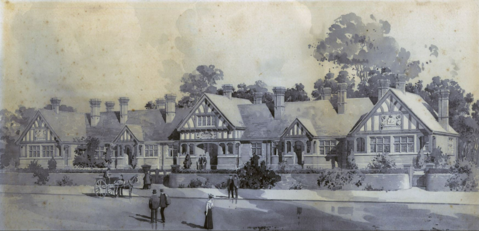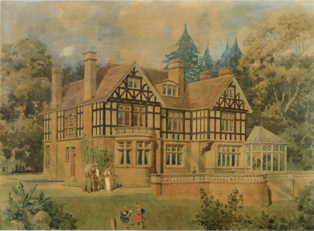Stedman Blower Architects
Script error: No such module "Draft topics".
Script error: No such module "AfC topic".
Stedman Blower Architects is one of the World's oldest architectural practices continuously operating, founded and still based in the Surrey/Hampshire borders of South-East England and one of the select few surviving firms that has its beginnings in the 19th century[1][2]. It continues to operate into the fifth generation. The practice’s archive of drawings, artefacts and documents remains almost complete and is a rare and substantive survival that records the day-to-day practice of architecture in a regional context during a dense period of English architectural history.[3]
Background[edit]
Stedman Blower was founded by Arthur Stedman in 1895 in the Surrey town of Farnham.[4] He was followed in practice by his son Leonard in the 1930s, who continued after Arthur’s retirement in the 1940s.[5] In the mid-1960s Leonard was joined in Partnership by Michael Blower. Michael became principal by the end of the 1960s, after which the practice was taken over by the latter’s sons Robert & Damien Blower in the 1990s.[6]
The Stedmans[edit]
The elder Stedman started out as an architect and surveyor after learning his profession through both apprenticeship as an articled clerk and study in the local Farnham School of Art, while working for local Surrey builders, Mssrs Goddards & Son. Although many architects would have learned their skills through an academic programme at a university department of architecture, it was then still possible to earn a RIBA certificate predominantly through practice, as Arthur.[4] In contrast, his son Leonard earned his RIBA certificate through the former route with degree studies at the Bartlett School of Architecture at University College London.[5]
The Stedmans, father and son, were part of a generation for whom modern architecture would have been quite alien, as they were both trained in a beaux-arts type system of architectural learning then prevailing, with close study of vernacular and classical architecture, with their traditions and details.[7] As such, while the practice flourished in its first decades, both two world wars and the advent of more modern materials and styles of architecture in the immediate post-World War II harmed the practice by the 1960s.[8]
Nonetheless, the practice built a great number of projects in its first 70-odd years, some of them now Listed Buildings, such as the Macdonalds Alsmhouses[9] and 49 Castle Street,[10] both in Farnham. These projects are good examples of vernacular and classical traditions within a local regional context, the best of many hundreds of such projects built by the Stedmans in the region.[11]
The Blowers[edit]
Michael Blower joined the practice in 1964, after Leonard had interviewed a number of candidates including James Gowan. His post-war architectural education, in contrast to the Stedmans, was much more alert to modern techniques of construction, use of materials and the international modern style by then dominating English architectural discourse. His early career at Scott Brownrigg & Turner had leant heavily on the modern style, but by joining Stedman he was also able to pursue a developing interest in traditional forms of architecture, such that through the period leading up to and including Postmodern architecture, he was increasingly aligned with those agitating for enhanced protection of historic buildings and historic urban landscapes; organisations such as Save Britain’s Heritage were then in the vanguard of this struggle. In a regional context, with the Farnham Buildings Preservation Trust and Roderick Gradidge, Michael preserved and adapted a number of fine and important historic buildings, many Listed.[12][13][14]
Michael's sons were both trained in an era of heightened conflict between contemporary, traditional and postmodern architecture – the ‘style wars’ - centred around Prince Charles’s then controversial polemic against modern architecture in both his 1984 speech[15] at the 150th RIBA Foundation event, as well as his 1989 book and BBCTV A vision of Britain. Passions having calmed since then, Robert and Damien embody a generation which is equally happy in both very traditional and contemporary camps[16], especially as adaptive reuse of old buildings and spaces has become central to architectural practice amid the global climate emergency[17][18][19][20]. Since Robert’s retirement, Damien has built greater knowledge and skills in conservation practice as a full member of the Institute of Historic Building and Conservation.[21][22]
The Blower Foundation[edit]
The Foundation, a registered UK charity founded in 2003 by Damien Blower, is leading a project to save and record architectural archives as an important patrimony for future generations to enjoy, before these vulnerable archives are destroyed or lost.[1] The Foundation is working with the RIBA on a project to widen skills and support available to the profession when archiving their architectural records and to enable wider public access through digital platforms.[23] The Foundation archives on and offline include thousands of documents and drawings from nationally important architects such as Sir Edwin Lutyens, Philip Webb, Detmar Blow and Harold Falkner amongst others. The archive also includes large and substantive surveys of locally and regionally important architects such as those buildings by Guy Maxwell Aylwin and Stedman Blower. The Foundation is closely associated with Stedman Blower, operating partially as a non-profit branch of, and sustained financially by, the practice.[1]
Gallery[edit]
-
Macdonald's Almshouses, West Street, Farnham, Surrey (Circa 1905/6), by Arthur J Stedman (1868-1858) for George Edward Macdonald Will Trust.
-
Project for a church in Ash Vale, Surrey by Arthur Stedman (Circa early 1900's)
-
Frensham Grange, Frensham, Surrey by Arthur Stedman (1908)
-
Proposals for a house in Frimley, Surrey by Arthur Stedman (Early 1900's)
-
Elevational line drawing of 30-36 South Street, Farnham, Surrey prior to demolition in 1990, by Michael Blower
Glossary of projects[edit]
- The Blower Foundation (for cultural connection) is a registered UK Charity devoted to cultural heritage and expression and Collections – Blower Foundation holds an online archive of drawings and buildings designed by the practice.
Principals and directors[edit]
1895–1945[edit]
- Arthur Stedman, FRIBA[24]
- Leonard Stedman, ARIBA[25]
1945–1995[edit]
1995–present[edit]
References[edit]
- Notes
- ↑ 1.0 1.1 1.2 "Where will the drawings go". Context. Institute of Historic Building Conservation. December 2022.
- ↑ McCloud, Grace (July 2022). "Lessons from the Past". The Almanac. London: Inigo.
- ↑ Curtis, William.j.r (1996). Modern architecture since 1900. London: Phaidon. ISBN 0-7148-3356-8. Search this book on

- ↑ 4.0 4.1 "No 100-Arthur J Stedman". Vol 1 Licenciates Nomination Papers. Royal Institute of British Architects. 1910.
- ↑ 5.0 5.1 "No 4075-Leonard R Stedman". Associate Nomination Papers. Royal Institute of British Architects. 1926.
- ↑ "Residential". Architects Journal. London: Metropolis International. 14 January 1999.
- ↑ "The Beaux-Arts Tradition". drawingmatter.org.
- ↑ [Farnham Herald 27th January 2006]
- ↑ "1-8, MACDONALDS ALMSHOUSES Farnham - 1243672 | Historic England". historicengland.org.uk.
- ↑ "49, CASTLE STREET, Farnham - 1044658 | Historic England". historicengland.org.uk.
- ↑ "FARNHAM CEMETERY CHAPEL, Farnham - 1272762 | Historic England". historicengland.org.uk.
- ↑ "Tancred's Ford, Surrey". Country Life. Country Life. November 1983.
- ↑ "How to recycle a house". Country Life. Country Life. September 1998.
- ↑ "Astragal-The Right Place". Architects Journal. The Architectural Press. April 1983.
- ↑ The Royal Family[1]
- ↑ "A mix of Styles". Building Design Magazine. London: United Business Media. 25 November 2005.
- ↑ Lutyens, Dominic (March 2004). "Brave New World". Grand Designs Magazine. Epping: Media 10 Ltd.
- ↑ White, Anna (26 November 2016). "The Architect Matchmakers". The Daily Telegraph. London.
- ↑ Lutyens, Dominic (8 February 2004). "Thinking Outside the Box". The Observer. London: Guardian Media Group.
- ↑ Elliot, Liz (17 March 2023). "A Country House Overlooking the South Downs". House & Garden. London: Condé Nast UK.
- ↑ IHBC
- ↑ Binney, Marcus (17 November 2012). "Conservation Register". The Times Newspaper. London.
- ↑ The Charity Commission[2]
- ↑ Pevsner, Nikolaus (2022). The Buildings of England-Surrey. New Haven: Yale University Press. pp. 119, 337, 345, 631, 688. ISBN 978-0-300-23478-7. Search this book on

- ↑ Pevsner, Nikolaus (2022). The Buildings of England-Surrey. New Haven: Yale University Press. pp. 328, 335. ISBN 978-0-300-23478-7. Search this book on

- ↑ Pevsner, Nikolaus (2022). The Buildings of England-Surrey. New Haven: Yale University Press. p. 97. ISBN 978-0-300-23478-7. Search this book on

- ↑ Pevsner, Nikolaus (2022). The Buildings of England-Surrey. New Haven: Yale University Press. pp. 336, 450, 685. ISBN 978-0-300-23478-7. Search this book on

- ↑ Pevsner, Nikolaus (2022). The Buildings of England-Surrey. New Haven: Yale University Press. pp. 195, 198, 372. ISBN 978-0-300-23478-7. Search this book on

- ↑ Pevsner, Nikolaus (2022). The Buildings of England-Surrey. New Haven: Yale University Press. pp. 195, 682. ISBN 978-0-300-23478-7. Search this book on

- ↑ IHBC
- ↑ "New Fellows". RSA Journal. London: Royal Society of Arts. October 2007.
- ↑ "Young at Heart". House & Garden. Conde Nast. March 2023.
- ↑ Pevsner, Nikolaus (2022). The Buildings of England-Surrey. New Haven: Yale University Press. p. 198. ISBN 978-0-300-23478-7. Search this book on

- Bibliography
- The Buildings of England: Surrey, by Ian Nairn & Nicholas Pevsner. London: Yale University Press, 2002 2nd ed (hardback, ISBN 0-300-09675-5 Search this book on
 .).
.). - West Surrey Architects, by Christopher Budgen. Woking: Heritage of Waverley, 2002 (paperback, ISBN 0-9542131-0-6 Search this book on
 .).
.). - Harold Falkner: More Than an Arts & Crafts Architect, by Sam Osmond. Chichester: Phillimore, 2003 (paperback, ISBN 1-86077-253-6 Search this book on
 .).
.). - Tancreds Ford, Country Life 17 & 24 November 1983, by Michael Hall
- Kingswood Hanger, Country Life 3 September 1998, by Clive Aslet
- Barns-Living in converted and reinvented spaces (pp 140–149), by Dominic Bradbury and Mark Luscombe-Whyte, 2004 (Conran Octopus, ISBN 1 84091 347 9 84091 347 9 Search this book on
 .).
.).
External links[edit]
- The Blower Foundation (for cultural connection) is a registered UK Charity devoted to cultural heritage and expression and holds an archive of drawings by the practice.
- Stedman Blower Architects Stedman Blower – Heritage Architects hold additional correspondence, archives and detailed information on further projects.
This article "Stedman Blower Architects" is from Wikipedia. The list of its authors can be seen in its historical and/or the page Edithistory:Stedman Blower Architects. Articles copied from Draft Namespace on Wikipedia could be seen on the Draft Namespace of Wikipedia and not main one.





